| During my solo teaching time at Orchard Elementary
School I took part in meetings with my two team teachers to create a rainforest
unit for K-1 students within the three classes. The unit was to take
place over 5 weeks and go over the rainforest in general terms and introduce
some of it many inhabitants..This unit was an interdisciplinary unit
(PC 2a1) that spanned theme time and it was integrated into lliteracy
and math. |
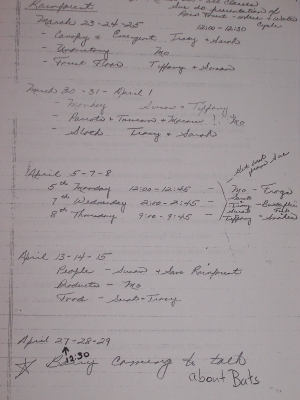
|
The rainforest is an important place for all students
to know and study about. Without the rainforest we would be devoid
of a lot of food, medicine, and most importantly oxygen. The rainforest
provides us with so many important things that we must all do out part
to help preserve the rainforest.
These kindergarten and first grade students have
spent all year studying about various parts of the world. In my time
here they have already studied the polar regions and the ocean. Our
next topic is the rainforest. They have studied each region in general
terms and discussed animals and plants that live in each region.
This unit is also relevant to the class because
of our students has recently visited the Costa Ricaan Rainforest and therefore
will be able to talk about it and connect it with the rest of our learnings.
Through various activities and teaching styles
the students will be able to give a general explanation of the rainforest
and the differences between some animals. This unit has been planned
for 63 students in either the kindergarten or the first grade. The
students come from 3 different classrooms and the unit has been planned
partially with 2 other teachers.
SKILLS:
Beginnings of cooperative grouping
Animal identification
Give clear directions
CONTENT KNOWLEDGE:
4 layers of the rainforest (emergent, canopy, understory,
forest floor)
facts about some animals in the rainforest ( frogs,
butterflies, snakes, monkeys, parrots and toucans, bats, and sloths.)
Other things that come from the rainforest (people,
products, and food)
Why we should conserve the rainforest (so many important
things come from the rainforest such as food, medicine, and oxygen)
VT STATE STANDARDS:
1.3a Students read for meaning, demonstrating
both initial understanding and personal response to what is read. This
is evident when students: Comprehend grade-appropriate materials
1.13a,b,c Students listen actively and respond
to communications. This is evident when students: Ask clarifying questions;
Restate; and Respond through discussion, writing, and using art forms.
2.2a Students use reasoning strategies,
knowledge, and common sense to solve complex problems related to all fields
of knowledge. This is evident when students: Use information from reliable
sources, including knowledge, observation, and trying things out
3.10 Students perform effectively on teams
that set and achieve goals, conduct investigations, solve problems, and
create solutions (e.g., by using consensus-building and cooperation to
work toward group decisions).
5.24 Students solve visual, spatial,
kinesthetic, aural, and other problems in the arts.
5.31 Students use the elements of vocal
and instrumental music, including rhythm, pitch, timbre, and articulation.
This unit will span over 5 weeks. The first
three weeks will be with my mentor teacher, while the last two weeks will
be during my solo weeks. The first three weeks I am responsible for
doing theme time which is our main time for unit. During my solo
weeks I will be responsible for the integration into other times as well |
| Books:
Rainforests by Lynn Stone
o Amazing Rainforests
o Vanishing Rainforests
o Rainforest at Night
o Animals of the Rainforest
Rainforest by Betsey Chessen (6)
Whos Hiding in the Rainforest by Susan Canizares (6)
Rainforest Colors by Susan Canizares (6)
Monkeys by Susan Canizares (6)
Who Lives in the Rainforest by Susan Canizares (6)
In the Jungle by Anne Miranda (2)
Rainforest by Helen Cowcher
Look Closer: Rainforest
Amazon ABC by Kathy Darling
Journey of the Red-Eyed Tree Frog by Martin and Tanis
Jordan
Jungle Days Jungle Nights by Martin and Tanis
Jordan
A Walk in the Rainforest by Kristin Jay Pratt
The Great Kapok Tree by Lynne Cherry
Rainforest Secrets by Arthur Dorras
Slowly, Slowly, Slowly, said the Sloth by Eric Carle
Canopy Crossing by Ann Whitehead Nagda
Where the Forest Meets the Sea by Jeannie Baker
Natures Green Umbrella by Gail Gibbons
Welcome to the Green House by Jane Yolen
Movies:
Magic School Bus: Rainforest
People of the Rainforest
Plants of the Rainforest
Animals of the Rainforest
Wild Rainforest
Websites:
http://www.enchantedlearning.com/school/index.shtml
http://www.therainforestsite.com
http://kids.ran.org/kidscorner/
Other Stuff: Worksheets that work with the lessons.
See me for copies. |
The list to the left is my resources list. This has most
of the books that were used during the unit. Other books that are
not listed were used by the other teachers in their lessons during their
theme time. Having many books is important as they
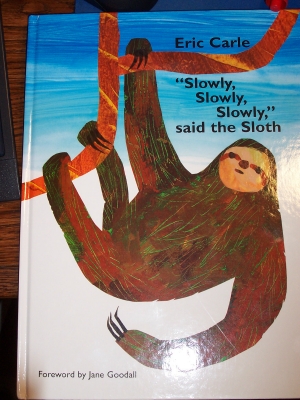
|
This is an overview of some of the lessons that I taught during this
unit. They are broad and diverse just like our theme unit in general.
I tried to use a variety of activities so that all children could be
successful. (PC 2c) This way, students that aren't good at books
could try something else.
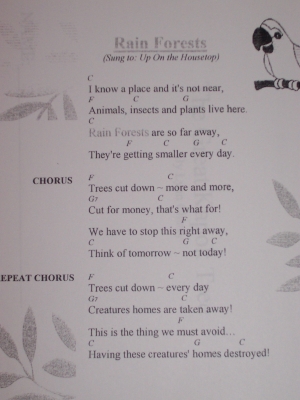 |
Emergent and Canopy In this lesson I start by pulling
out two books (Rainforest Secrets and Natures Green Umbrella). There
is no story about the emergent layer and the canopy to give them the information
that I want so I introduce the term research to the children and show
them the two books. I open Rainforest Secrets and read a small section
on the canopy and make the distinction that the canopy and the emergent
really are separate. I also linger on epiphytes (air plants).
I then show them the really nice picture of animals and plants in the canopy
and emergent layer in Natures Green Umbrella. I again spend time
on epiphytes. I then introduce the activities for the day.
Coloring the 2 sections of the rainforest that we studied and then making
their own epiphyte on a tree branch (a bromeliad)
Sloths For this lesson I will start by reciting a
poem about sloths. Then I will read them Eric Carles book Slowly,
Slowly Slowly, said the Sloth. Then we will move on to making our
own sloths. This lesson is wrapped up by filling in a sloth with
facts up on the board. See Lesson Plans attached for full lesson
plan.
Butterflies For this lesson I start by placing on
my pair of butterfly wings. This gets the children excited because
we are going to be studying butterflies. I have the children sit
around the computer and looking up at the screen. I have the screen
opened to http://www.zoomschool.com . I go to their butterfly section
and read portions about butterflies from the page. I spent a little
time talking about the life cycle and reading what the page says.
I ask for things that they are learned as we go along. I introduce
the first activity which is completing a cut and paste activity on the
butterfly life cycle. I do this with the students on the overhead
projector asking students to read and point out what is next. After
the paper is done I pass out the butterfly sheet. On this they color
their butterfly and cut it out. Later I add an antennae that is their
choice of color. While the students are working I will walk around
and get two or more facts from each table about butterflies.
Food From the Rainforest In this lesson I will start
by pulling out food that I have collected from my home that originated
in the rainforest (such as peanut butter, oranges, popcorn, soda, chocolate,
coffee, cloves, paprika, macadamia nuts and peanuts). Then I will
ask the students why I have all these foods (because theyre from the rainforest!)
Next I will have the students listen as I read a paper about rainforest
foods. Next I will have the students list foods from the rainforest
that they know or just learned. After they have listed the foods
I will go over their rainforest foods booklet. The students will
then work to finish the booklets. Students will get to enjoy a small
handful of popcorn during this lesson.
Kapok Tree This lesson will be taught during literacy.
First I will teach the children a new song about the rainforest.
The song is about how the rainforest is being destroyed and we must stop
it. Then I will have a parent read the book, The Great Kapok Tree
by Lynne Cherry. After the story I will ask students about the story
and ask them what the main idea in the story was as well as some of the
animals in it. The students will then go to their seats. A
booklet will be passed around about the Great Kapok Tree. I will
read through the story and ask the children to point along and help me
read it. Then I will put the overheads up and ask the students to
help me fill in the blanks. After each page we will pause to have
either myself or a parent draw pictures on the overhead. The students
will illustrate their books after we are finished.
Complex Instruction: This will be used in the last
week of the unit. It will be used for both assessment and as a fun
way to end the rainforest unit. Before the CI rotation I will be
introduce how to work in groups to the children. This will include
direction giving, listening skills, and how to compromise. The activities
in the rotation will be making a emerald boa or a boa constrictor, making
a song about the rainforest with facts, and making a diorama of the rainforest.
The students will be working in groups of 3 or 4 to complete the projects.
The rotation will take three days and then a day later to review what we
did.
|
| During my food from the rainforest lesson I recognized that the classroom
was going crazy. Children were all over the place, I was being pulled
all over the place, and work wasn't getting done efficiently. In
between children asking me to spell words for the book. I thought of a
better way to begin my lesson. In most cases, you can not go back,
however, since I teach each lesson 3 times during theme time I was able
to adapt this plan. The next day I chose to start by brainstorming
ideas for the books before they started to fill them in. This cut nearly
all requests for spelling words for children out and I was able to work
with the students who really needed my help. Two students from next
door was unable to sit in their seat, copy words from the board, and work
effectively. I moved them to a different table and copied the words
down on a piece of paper so that they would be able to see better.
By differeniating the intstruction (PC 2b) for these two children
they were able to get their work done before many of the other children. |
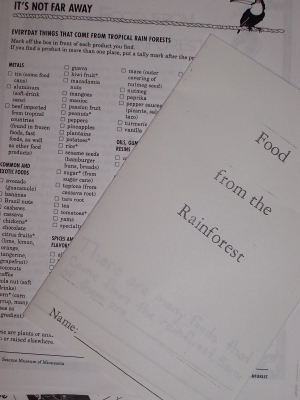
|
I was able to assess the children a few different ways during this
lesson. Most of my assessments were done informally through questioning
and looking at their projects. One way that I assessed was by asking
for facts at the close of both the butterfly and sloth lessons. For
the Sloth lesson I asked the students to tell me facts and I wrote them
inside a giant sloth that I had drawn on the board. I got a variety
of facts that told me that children were listening. each child got
to call out a fact that they learned. This animal interested the
students a lot so they were able to tell me many facts.
For the butterfly lesson I walked around to each table and asked
students to come up with 5 facts per table, one per child. Each table
told me their facts and I found that they had remember a wide range of
facts.
Throughout the unit I also asked many students things that they
had learned about the lessons that the other teachers were teaching them.
Some children were unable to answer questions while others were able to
give off many facts.
The last way that I used assessment in my unit was to look at
their CI projects. I asked them to use things that they had learned
in both their song and their diorama. The students would explain
their projects to me and I would listen to their songs to see if the groups
included what I wanted. |
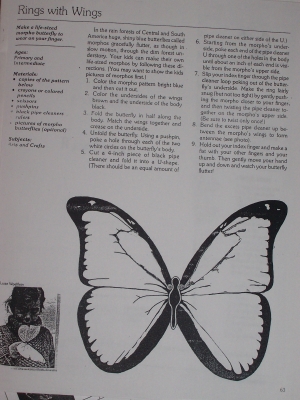
|
| This unit and my solo time went pretty well together.
I found that the students really enjoyed learning and were able to get
excited about the theme. The students would bring in theme related
items that would be placed around the room and we had a jungle at the end
of the unit. Teaching over a period of time was a challenge, but
I learned a lot while doing it. A variety of different activities
helps the children learn and stay excited about their different themes.
I'm excited to have more of a say in the topics that I will be teaching
in the future as well as trying out more types of assessment. I would
like to work more on rubrics in my next unit plan. |
|